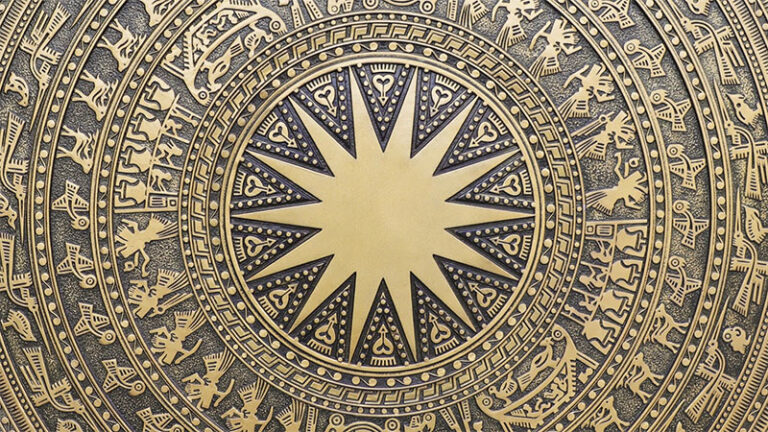
For many generations, the Dong Son drum has represented the Dong Son Culture and the Red River civilization of ancient Vietnamese people when the Hung Kings built the Van Lang country and has become a sacred symbol of Vietnamese national culture. The image of the bronze drum is not only a precious treasure of Vietnamese traditional culture but also a convergence point of the holy souls of rivers and mountains formed when the Hung Kings built the country and accumulated national quintessence throughout the historical process of making the country and defense of the Vietnamese people from the era of the Hung Kings to the glorious Ho Chi Minh era. Dong Son bronze drums discovered throughout Vietnam have eloquently proven that. During thousands of years of building and defending the country, the bronze drum has been a cultural artifact symbolizing the cultural quintessence as well as the indomitable will of our people.
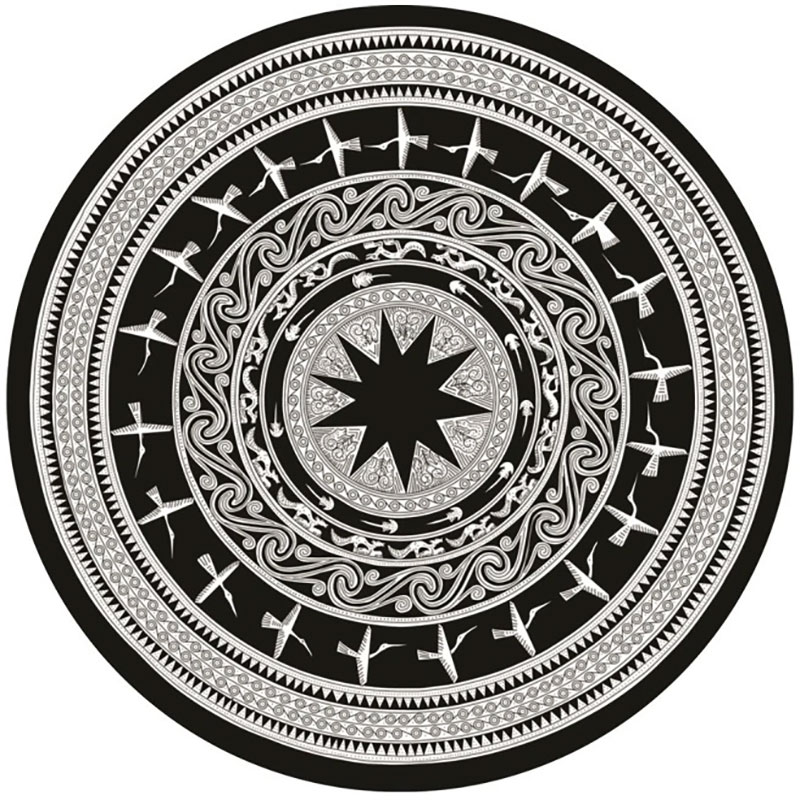
Contents
- 1 History of Dong Son culture
- 2 Origin of Dong Son drum
- 3 Inheritance of Dong Son bronze drums in Vietnam’s feudal period
- 4 Types of Dong Son bronze drums
- 5 Learn the meaning of patterns and motifs on Dong Son bronze drums.
- 5.1 Represents the weather of the year
- 5.2 Image of a big star in the center of the Dong Son bronze drum
- 5.3 Images of birds and animals on the surface of Dong Son bronze drum paintings
- 5.4 Image of stilt house on Dong Son drum
- 5.5 Image of musical instruments on the surface of Dong Son bronze drums
- 5.6 Images of people’s daily activities
- 6 Technology and art of crafting Dong Son bronze drums
- 7 The meaning of the Dong Son drum in national life and culture
History of Dong Son culture
Dong Son culture appeared during the Bronze Age and was famous for its bronze drums. It thrived in the Red River Delta from the seventh century BC to the second century AD. The people under the Dong Son Dynasty, also called Lac Viet, are considered the ancestors of modern Vietnamese people. Dong Son is named after a village south of Hanoi, where their artifacts were first discovered.
Dong Son civilization is considered the most unique early civilization in Southeast Asia. Dong Son people live by hunting, fishing, and growing rice. They are also skilled metalworkers, producing amazing bronze drums. The Dong Son civilization ended when it was invaded by the Chinese (Northern) in the 2nd century BC.
Achievements: The Dong Son culture produced countless bronze objects, including tools, vases, ornaments, weapons, arrowheads, axes, and bells, as well as ceramics and beads. The most impressive objects they made were the large, beautifully decorated gongs. The distribution of Dong Son drums is one of the most vital signs that trade between Vietnam and Southeast Asia was widespread during this period. Early Chinese documents indicated China’s commercial interests in the region and detailed the objects of trade they sought, such as rhino horn, ivory, medicinal plants, and forest products. The Chinese dominated northern Vietnam for a thousand years, and their influence is evident in later Dong Son artifacts.
Artifacts from Dong Son were first excavated in the 1920s. It is generally believed that it was not the true political center of Dong Son’s culture but merely one of Dong Son’s principalities. Paint is loosely bonded together. The center of Dong Son culture is the central area of the Red River basin.
Dong Son society is an agricultural society based on wet rice cultivation. The images on Dong Son bronze drums vividly depict activities associated with damp rice production, such as people holding plows and buffaloes, cows going to the fields to work, and farmers grinding rice with hand pestles. The water offering ritual is depicted on the drum’s face and body. The boat racing scene is said to represent village festivals that celebrate the supreme role of water in agriculture. Images of Dong Son warriors and their weapons are found on many bronze drums. Many types of weapons are displayed: crossbows, javelins, axes, spears, daggers, and shields. These images confirm the historical context of the Dong Son period when residents here constantly struggled for survival with the Northerners.
Social events are depicted on drums through images of dancers, musicians, and musical instruments. There are bronze drums, bells, beats, senh (a rattle of bamboo tubes tied to the hands or feet to make sounds when dancing), and Khen (a musical instrument with 4 to 6 long tubes attached to a resonating box). On Ngoc Lu and Hoang Ha bronze drums, there is an image of Dong Son people sitting in rows on the floor playing bronze drums with drumsticks. Dancers in ceremonial costumes process counterclockwise, each holding a musical instrument or weapon in one hand while the other forms some rhythmic gesture.
Research and archaeological documents from Vietnam have shown that Dong Son originated from Phung Nguyen culture, and inheritance is evident in both antiques and patterns.
Famous Vietnamese archaeologist, Ha Van Tan, in his article “From Phung Nguyen Pottery to Bronze Drums” (Tu gom Phung Nguyen den Trong dong) published in Archeology magazine No. 13 (1974), demonstrated the inheritance of patterns in Phung pottery. Originally in the patterns of Dong Son culture. From the archaeological basis, it can be affirmed that Dong Son culture developed from the foundation of Phung Nguyen culture, inheriting types of antiques, patterns, and the development of cultural antiques. Dong Son is clearly shown in Dong Dau and Go Mun cultures, with axes and weapons that are the precursors that later formed Dong Son culture.
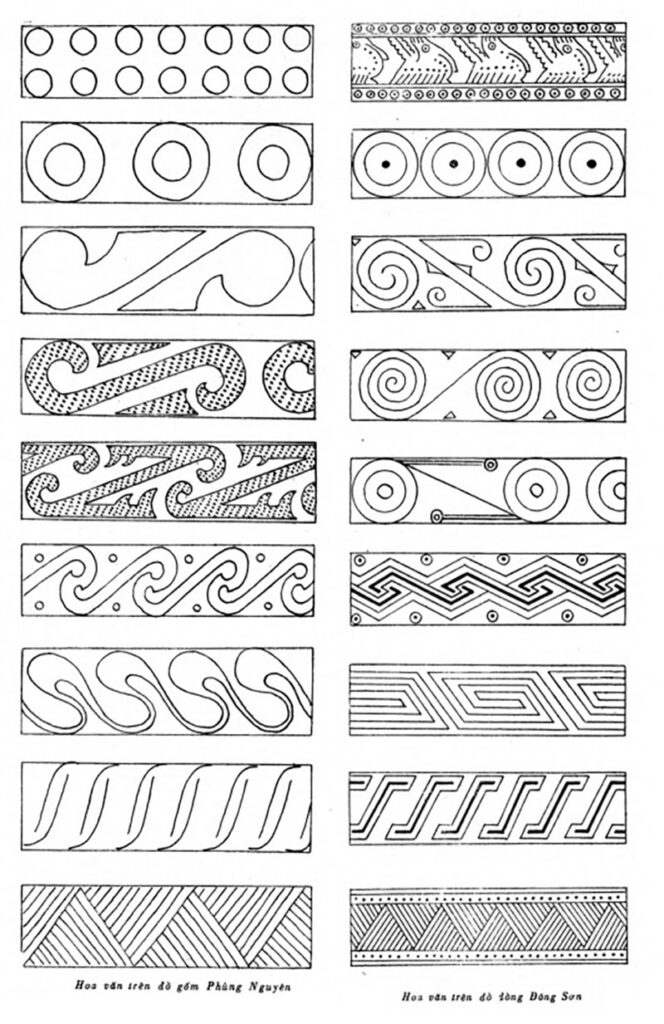
Origin of Dong Son drum
The controversy regarding the origin of bronze drums focuses mainly on two centers formed in ancient times, namely Vietnam and Yunnan; these were the two largest bronze drum production centers in the early stages of the development of bronze drum culture.
Regarding dating, Vietnamese archaeologists estimate the age of Vietnamese bronze drums to be around the 7th-8th centuries BC. In contrast, Chinese archaeologists estimate the age of Chinese bronze drums to be around the 7th century BC. 7 BC. The chronology of bronze drums in the two regions does not differ much. The type of drum that is argued to be the ancestor of the Dong Son drum is the Van Gia Ba drum. In Vietnam, 20 similar drums with total development progress have been found. Among these 20 drums, only two drums have been determined to be brought by the Dien people to the Northwest region of Vietnam.
Based on these studies and evidence, it can be affirmed that Vietnam is one of the two earliest centers of bronze drum formation; besides Yunnan, the drum model dating back to about 850 BC shows that The bronze drum may have originated from Vietnam.
According to researchers, Dong Son culture and Dien Viet culture are two symbiotic cultures of the Vietnamese community in southern China and northern Vietnam.
Dong Son bronze drums are associated with the period when the Hung Kings built the Van Lang country. The homeland of Dong Son bronze drums is the ancestral land of Phu Tho midland and the northern and North Central provinces of Vietnam. The Phu Tho area is the center of Dong Son Culture—Red River Civilization.
The center of a cultural artifact is often where the most significant number of artifacts is concentrated. This is also a basis that shows that Vietnam is the largest bronze drum production center in the early stages of formation. Vietnam is also where the enormous bronze drums were found during the existence of the mainstream Dong Son culture, which are Ngoc Lu, Hoang Ha, Co Loa drums (currently in Vietnam), and Song Da drums. (presently located in the Guimet Museum, France). The large drums in other regions were all cast in early AD, after the collapse of Dong Son culture.
Dong Son Bronze Drum is the achievement of which cultural stage?
The Dong Son Bronze Drum is an iconic artifact from the Dong Son culture, which thrived in modern-day Vietnam from around 600 BCE to 200 CE. This cultural stage is often classified as part of the prehistoric period in Southeast Asia. The Dong Son culture represents a significant stage in the region’s cultural and technological development, characterized by advancements in metallurgy, artistry, and social organization.
The Dong Son Bronze Drum is a testament to this era’s cultural and technological achievements. These drums were meticulously crafted using sophisticated bronze casting techniques, showcasing the Dong Son people’s mastery of metallurgy. The drums were not merely functional instruments but also held symbolic and ritualistic significance within the Dong Son society.
These bronze drums were typically large and adorned with intricate designs, depicting scenes from everyday life, mythological motifs, and symbols of power and prestige. They were likely used in various ceremonial and religious contexts, representing social status and cultural identity. The craftsmanship displayed on these drums reflects the artistic sophistication of the Dong Son culture and their appreciation for intricate detail and aesthetic beauty.
During this period, the Dong Son Bronze Drums were also significant in their role in trade and cultural exchange within Southeast Asia. They have been found in archaeological sites across the region, suggesting widespread connections and interactions between different communities. This indicates that the Dong Son culture was part of a more extensive trade and cultural exchange network that spanned Southeast Asia.
Overall, the Dong Son Bronze Drum represents a remarkable achievement of the Dong Son culture, showcasing their technological prowess, artistic skill, and cultural sophistication. These drums remain revered as archaeological treasures and cultural symbols of Southeast Asia’s rich and diverse heritage.
Inheritance of Dong Son bronze drums in Vietnam’s feudal period
Historical documents and artifact evidence have shown that bronze drums were inherited and used continuously in Vietnamese feudal dynasties, from the Ly Dynasty to the Nguyen Dynasty.
To further consolidate research proving the origin of bronze drums and Dong Son culture, it is necessary to consider the inheritance of bronze drums in the medieval period. All feudal dynasties, from Ly-Tran-Le-Nguyen, cast and used bronze drums.
During the Ly-Tran period, the Vietnam History Museum collected five drums engraved with Dragon images from this period [16]. Dragon images in the Ly and Tran dynasties were only used for royalty, so the representation of Dragons on bronze drums shows that these drums were cast and used for court activities of these dynasties.
During the Le Dynasty, Toan Thu and Cuong Muc also recorded the use of bronze drums in court activities of this dynasty.
Complete History of Dai Viet records: “十 五 日 帝 親 率 百 官 拜 謁 山 陵 乃 旨 揮 籃 山 等 陵 官 係 本 祠 各 役 務 要 誠 敬精 潔 斬 木 伐 竹 採 取 柴 薪 寢 廟 用 牛 四 擊 銅 鼔 軍 士 讙 應 .” – “On the fifteenth day, the emperor’s body and hundreds of officials worshiped Son Lang. Nai commanded the Lam Son tomb mandarins: “The system consists of basic services such as pure reverence, cutting wood, cutting bamboo, Thai Thu, Sai Tan, soaking temples, using ox four, ancient bronze jacks, and soldiers responding.” – Translation: “On the 15th, the king personally led hundreds of officials to worship the So Mausoleum and ordered the mandarin in charge of the mausoleum at Lam Son that: “Everything at the temple needs to be respectful and pure like falling trees, cutting covers, Collecting firewood… used four buffaloes to impregnate the temple, beat bronze drums, and the soldiers cheered in response.”
Dai Nam Thuc Luc was also recorded using bronze drums during the Nguyen Dynasty. The History Museum’s collection also has a drum engraved with the image of Dragon and Phoenix in the Nguyen Dynasty, showing that it was used throughout. Royal activities.
Dai Nam Thuc Luc recorded: “Re-defining the rules prohibiting the gates of the Imperial Citadel. (Every day at dusk, the first watch, at the end of 9 o’clock, a bronze drum is beaten; at the end of 10 o’clock, there are two gunshots, and all doors are closed. At the fifth watch, at the end of 7 o’clock, the bronze drum is beaten, and at the end of 8 o’clock, there are also two gunshots; all doors are open. On high tide days, at the beginning of the fifth watch, three drum beats are played; at 8 o’clock, the gun is fired to open the door as usual.”
Types of Dong Son bronze drums
Many types of Vietnamese bronze drums originate from the Dong Son drum, a type I He-Ghe drum, according to the classification of a German archaeologist.
Vietnamese scholar Pham Huy Thong classified and divided the Heger I drum of Dong Son culture into five groups in 1990.
- Group A includes a large and intricately decorated drum set.
- Group B consists of a smaller drum, most likely with a group of waterfowl in flight as their central motif on the eardrum and mantle design.
- Group C has a tympanic surface of a row of feather-clad warriors placed within another panel of waterfowl in flight. Toadstools line the edge of the membrane, while the mantle is decorated with boat-related or geometric patterns. The drums listed below date from the 5th to 1st century BC.
The Heger II drum: the drum body has only two parts, no human or animal shapes; instead, it is full of geometric patterns. On the drum surface, there is usually a shape of four toads, sometimes six. The sun has eight rays. This type is distributed in the Guangdong and Guangxi regions of China. In Vietnam, the Muong people also use many kinds of drums, so some call them Muong drums.
The Heger III (Tan Do bronze drum) was displayed at the Vietnam History Museum, Hanoi, Vietnam.
The Heger III drum has beautiful small handles. The sun has 12 wings. The four corners of the face have toads. Usually, three overlap each other to form 12. They are decorated entirely with geometric motifs and patterns. At the foot is a troupe of embossed elephants walking around the “Tree of Life.” Sometimes, snails replace elephants. They were discovered in Vietnam, Laos, Thailand, Myanmar, and Yunnan (China).
The Heger IV bronze drum (Long Doi Son bronze drum) is displayed at the Vietnam History Museum in Hanoi, Vietnam. Heger IV drums are usually small and do not have a toad. The star always has 12 rays, and sometimes, the names of 12 terrestrial animals are visible. They are found in China and Vietnam.
The Ngoc Lu drum is the most important of the Dong Son bronze drums. The drum was accidentally discovered in 1893 in Ha Nam province, southeast of Hanoi, and not during a planned archaeological expedition. In contrast to most other Dong Son drums, the eardrum has three concentric panels depicting animals or humans interspersed with bands of geometric or circular patterns. The innermost panel appears to be a self-referential depiction, as it is decorated with images of people seemingly performing a ritual involving the drums themselves. Other musical instruments and rice planting and harvesting activities are also shown. The two outer panels are decorated with scenes of deer, hornbills, and herons.
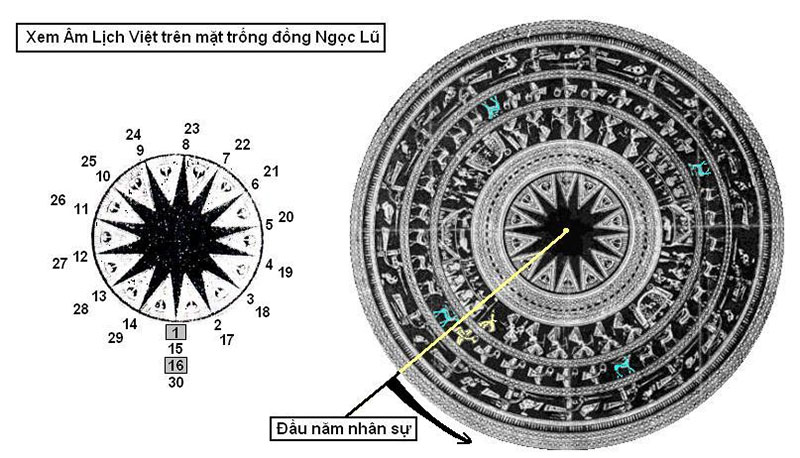
The Hoang Ha drum was discovered in Ha Son Binh province in 1937 near Hoang Ha village, with the outside showing herons and the inside showing a procession similar to that depicted on the Ngoc Lu drum, the famous drum of the Dong Son Drum. Four feathered men are depicted walking in a line, brandishing spears, with two musicians accompanying them. A person is shown standing under the eaves of a house, beating a drum while the rice fields are left unattended, to feed a rice bird that plans to thresh the grain. The boats depicted on the drum’s mantle are very similar, with a similarly slit prow, archers standing on raised platforms, and a drum. However, the drum differs from the Ngoc Lu drum in the absence of animals.
The Co Loa drum is the most famous among the Dong Son drums. The Co Loa drum only has two warriors holding spears, unlike the Ngoc Lu drum. Another difference is that the percussion ensemble consists of three drummers, one drum located under the eaves of the house. Meanwhile, an extra person is depicted in the process of threshing rice. The man has long hair and is sifting grain into a bowl. Percussion ensembles are also described differently because the drummers do not all drum in sync. Two drummers are depicted in contact with the drums, while the remaining two drummers hold batons in an elevated position.
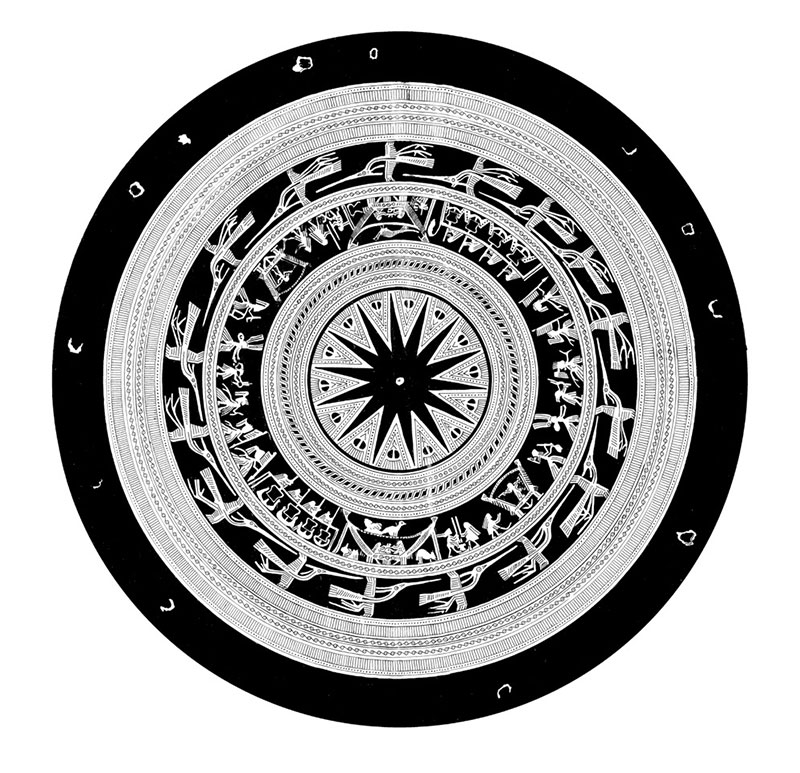
The Song Da drum was discovered in Ha Son Binh province in the 19th century. The drum shows a procession similar to that described in the Ngoc Lu drum, the most famous of the Dong Son drums. This drum differs in depicting four groups of men in procession with feathered headdresses instead of two. Additionally, each group consisted of three or four people, none of whom appeared armed. The men’s posture is understood to mean they participate in a dance rather than a military ceremony. This drum only depicts a pair of people threshing rice; no one is playing the cymbal. However, general motifs, such as the boats on the mantle, remained unchanged.
The Quang Xuong drum from Thanh Hoa province is another specimen believed to be of possibly later origin. However, the drum is smaller, making the image more difficult to interpret. Large drums found in Northern Vietnam are generally in the minority, as most drums have simple decorations and fewer human figures. The Ban Thom drum only has an interior with four houses and human figures standing alone or in pairs.
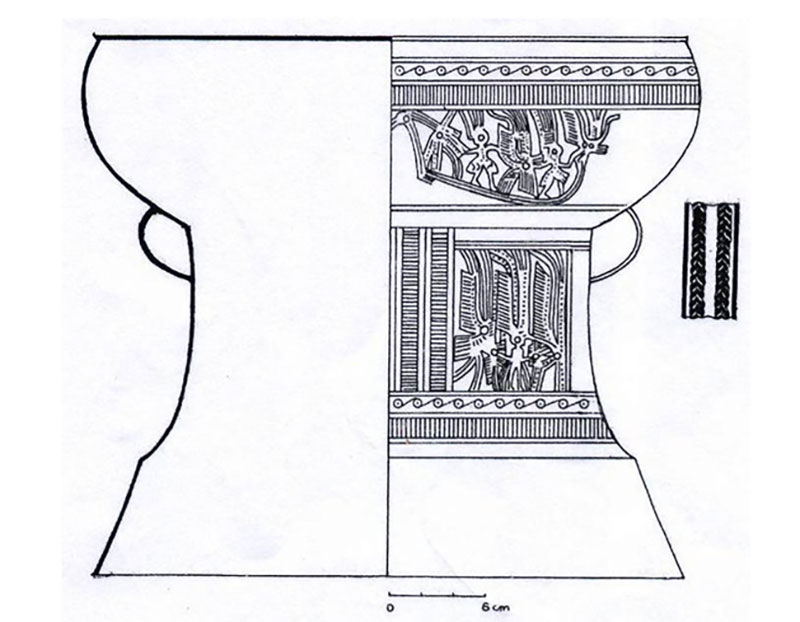
Scientists classify the Kinh Hoa drum as one of the earliest and most precious drum groups, named group A1 among the most beautiful bronze drums of Dong Son culture, such as Ngoc Lu, Hoang Ha, Song Da, and Co Loa. Drum head: Round shape, bulging tang, body divided into three parts. Size: Face diameter: 89.0cm; Drum body height: 59.5cm; Drum leg diameter 98.5cm; heavyweight 110kg. The drum’s shape is beautiful, and its size and weight are close to those of the Ngoc Lu drum group.
Learn the meaning of patterns and motifs on Dong Son bronze drums.
There are many extraordinarily diverse and rich patterns on the surface of bronze drums, including stars, stray birds, musical instrument symbols, ancient costumes, images of ethnic stilt houses, and traditional activities—human life activities such as dancing, drumming, etc. The patterns on the bronze drum’s surface are not simply decorative images but have profound meanings of culture, tradition, and national pride.
Represents the weather of the year
Including the winter solstice and summer solstice, it demonstrates the laws of weather that occur cyclically, affecting the activities and lives of all species.
Winter solstice At the radius extending from the center of the flower, the picture shows a house on stilts, with a couple of birds on the roof and three people lying down and getting up. On the right corner of the floor appeared an object that looked like a mortar lying on its side, and on the left corner was a child tapping a small drum as if trying to wake the whole house up. Through this, it can be understood that through a cold winter, animals sleep to avoid the cold until the winter solstice wakes up, at this time the buds of flowers, leaves, birds, and animals also begin to bloom to greet the warm weather…
Summer solstice: Opposite the winter solstice is the summer solstice—images of stilt houses with male birds on the roof, especially those living harmoniously with humans. Since ancient times, our ancestors have believed that in the summer, they should build rafts to do good deeds, not destroy bird nests, and if they see them, they must release them. The female birds may be incubating eggs and raising their chicks. That is also why there is an image of a boat on the drum surface.
Image of a big star in the center of the Dong Son bronze drum
The central star image in the middle of the bronze drum surface (8 to 14 petals) is the most beautiful symbol of the Dong Son bronze drum: the star represents the supreme image in nature, the sun. Since ancient times, people have believed that the sun provides them with energy and light, so they worship and are grateful.
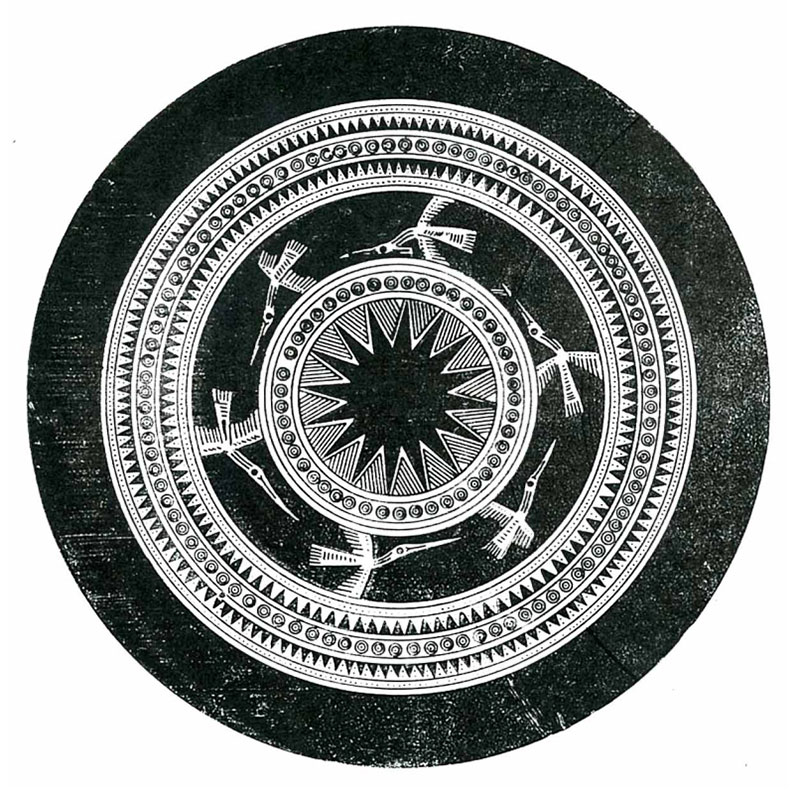
In addition, the star image in the center of this drum is also a celestial chart that allows determining the days of the year. It is a type of lunar calendar, combining lunar and solar cycles, originating from Bach Viet culture, imbued with wet rice agricultural culture in the South.
The numbers of rays, flying birds, deer, and boats were mainly even, showing that the residents at that time knew how to measure. Most rays 12 are related to the number of months in the year.
Images of birds and animals on the surface of Dong Son bronze drum paintings
The images of Lac and Hong birds – considered totems of the Lac Viet people – are highly stylized and densely distributed on the drum surface in many different positions and shapes. From birds flying and perching to birds standing with their beaks touching each other. Interspersed with that are images of deer – animals known for their gentleness and familiarity with humans living in nature.
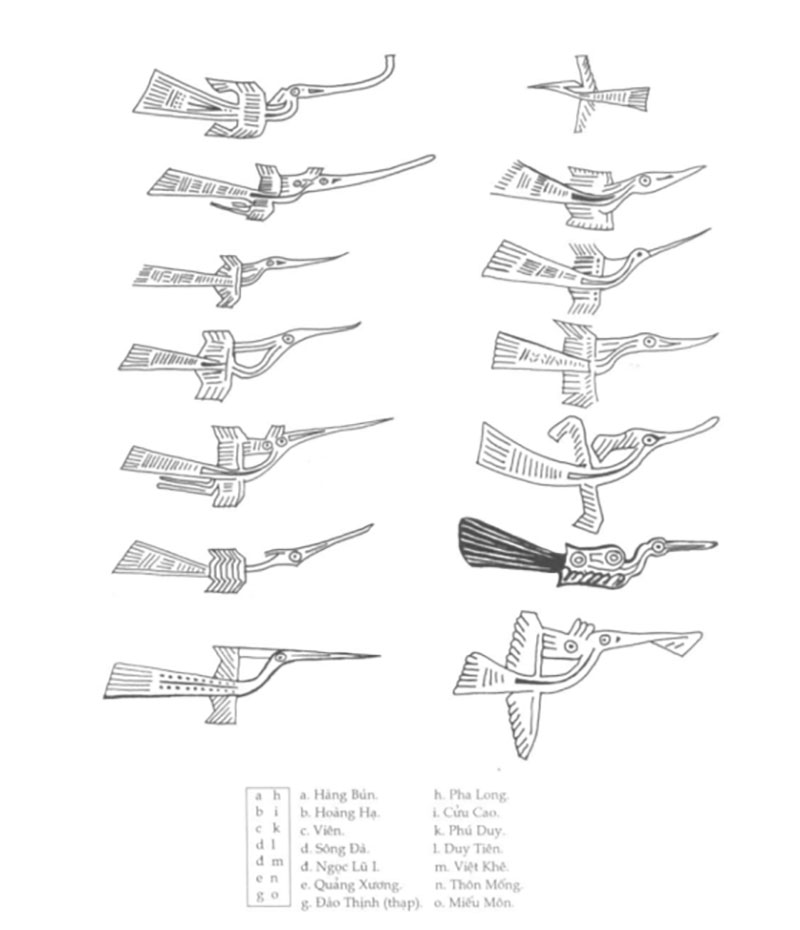
Images of birds on the drum represent the worship of nature. With the concept that birds are humanity’s ancestors, the image of an egg in the Lac Long Quan – Au Co legend or bird motifs expresses gratitude to ancestors.
Image of stilt house on Dong Son drum
The bronze drum face motif uses the image of a stilt house and can be seen in almost all types of bronze drum paintings, with the architectural kinds of curved-roofed houses and round-roofed stilt houses. The image of the house has two pillars at the front, and the two ends and the middle have a ladder on the floor. These curved roof houses are people’s homes.
This is also considered the most straightforward bronze drum performance. Still, it brings characteristics of traditional culture and represents a part of people’s lives during the early period of nation-building.
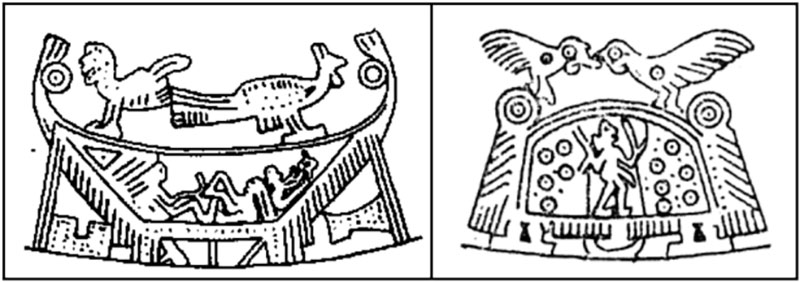
Image of musical instruments on the surface of Dong Son bronze drums
On the surface of the Dong Son bronze drum, there are usually two main musical instruments engraved: drum and trumpet. People in our country often play these two musical instruments at festivals or Tet holidays. There are two types of drums:
Drums perform in a drum ensemble. The drummer will stand or sit on the floor. Now, hold the long stick and hit vertically. Drums are placed on shelves close to the ground. This fighting type is still seen at Muong festivals, such as in Hoa Binh province.
The one-person drum performer holds the drum in the house or on the boat to keep the beat.
Images of people’s daily activities
The decorative bronze drum motifs depicting people’s daily lives, such as drumming, dancing, pounding rice, rowing boats, etc., are simple but highly symbolic. They clearly depict features of a peaceful, happy, and prosperous life in the early days of the country.
Images of dancing dancers, national costumes, scenes of people gathering, and living activities depicted on bronze drums represent the most beautiful and unique things in ancient Vietnamese people’s cultural and spiritual life… These bronze drum motifs have high artistic and historical value and convey precious national identity to future generations.
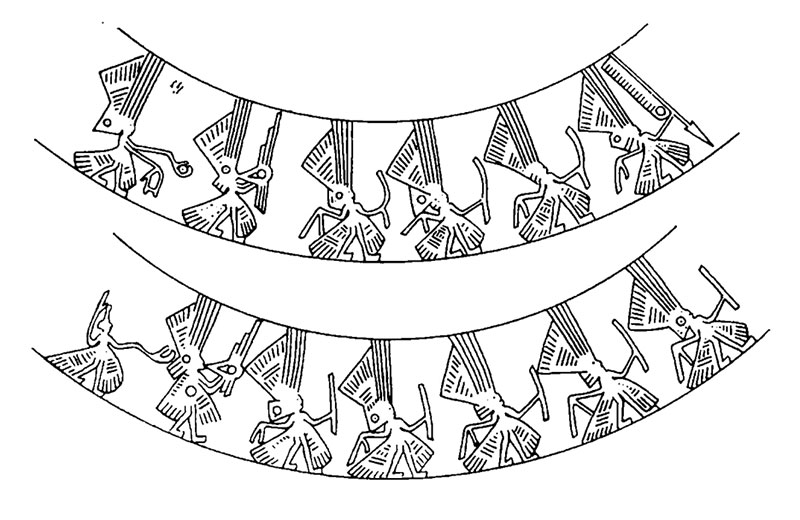
Technology and art of crafting Dong Son bronze drums
Traditionally, scholars have traced its bronze casting technology to northern China. This theory is based on the assumption that bronze casting in East Asia originated in the north of China; however, this idea was refuted by archaeological discoveries in northeastern Thailand in the 1970s. In the words of one scholar, “bronze casting began in Southeast Asia and was later adopted by China borrows, not vice versa as Chinese scholars always assert.” The work of modern Vietnamese archaeologists supports such an interpretation. They discovered that Dong Son’s earliest bronze drums were closely related to the pottery of the Phung Nguyen culture in terms of essential structural features and decorative designs.
Most bronze drums are made in Vietnam and Southern China but are traded as far south and west as the islands of Java and Bali and are prized by people of very different cultures. Dong Son drums demonstrate advanced techniques and great skill in casting large lost wax objects; Co Loa drums would have required smelting 1 to 7 tons of copper ore and simultaneously using up to 10 castings in a large crucible. Most scholars agree that Dong Son’s drum demonstrates artistic perfection that few cultures of that time could match. Dong Son drums, especially the first drums, are decorated with rich and reasonably arranged images of objects, people, and animals. Together, these images provide a vivid depiction of Dong Son society, its people,
The decorative images on the tympanum follow a general pattern: in the center is a star surrounded by concentric panels depicting human or animal scenes interspersed with bands of geometric motifs. Birds, deer, buffalo, and hornbills have been described. Historians have identified a connection between Van Lang and tu lang (or blang), a large bird in the Vietnamese-Asian language. In addition, the Hung Kings also chose the heron, a water bird, as the totem of the Van Lang country.
The meaning of the Dong Son drum in national life and culture
The bronze drum is not only a sacred object, but through which many issues have been clarified for us; it is a message that creates the most concentrated symbol of achievements in economic, cultural, and social life and the power of a nation. The first state was established in our country – Hung Vuong State.
The Dong Son drum and its engravings help us imagine the life of ancient Vietnamese people. Bronze drums have many patterns, with reasonable arrangements on the face, drum, and body. Researchers studied and analyzed them to serve as a scientific basis for classifying drums and portraying the economic, social, and cultural features of Dong Son at that time.
Bronze drums have musical and other functions, such as symbols of power and religion. Drums are used in religious ceremonies, festivals, and in fighting against foreign invaders when the tribal leader calls people from all over to gather to fight together.
Drums often belong to leaders and symbolize power—the more influential the leader, the more giant and beautiful the drum. Bronze drums are valuable assets used as funeral items when the owner dies.
Dong Son drum is a product of developed agricultural civilization, an extremely precious artifact, and one of Vietnamese culture’s significant points of pride.